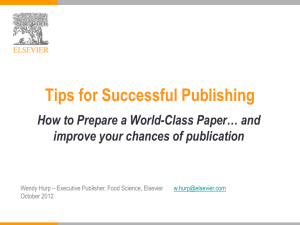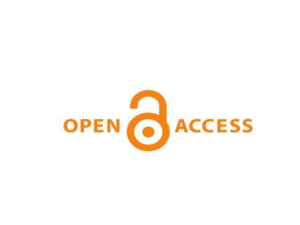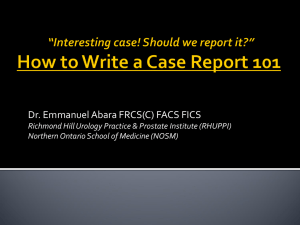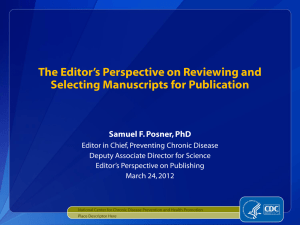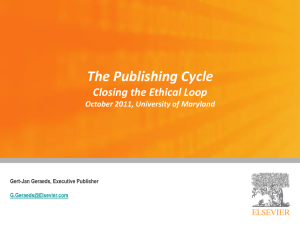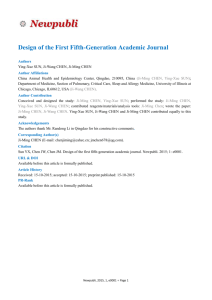Taylor & Francis Slides for 2011 CONCERT annual meeting
advertisement
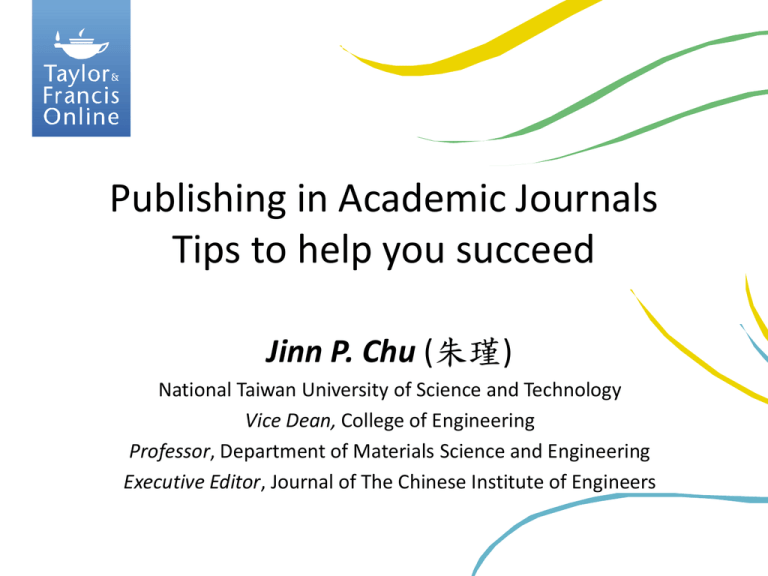
Publishing in Academic Journals Tips to help you succeed Jinn P. Chu (朱瑾) National Taiwan University of Science and Technology Vice Dean, College of Engineering Professor, Department of Materials Science and Engineering Executive Editor, Journal of The Chinese Institute of Engineers Publishing in Academic Journals • • • • • • • • • • Who we are and what we do Journal Publishing Cycle and the Peer Review Process Audience and Type of Publication Choosing the Correct Journal Assessing the Best Journal for your Article Writing for your Chosen Journal Preparing the Journal Manuscript Some Journal Publishing Protocol Help for Prospective Authors Reasons Why Journal Articles are Rejected Look out for our Publishing Top Tips! Top Tip 2 Some Publishing Trivia • When was the first scholarly journal published? a) 1565 b) 1665 c) 1765 3 Philosophical Transactions 4 Who are you? • Professor • PhD • Post doc • Masters Students • Undergraduates 5 Start of the Publishing Cycle 8. Proofread and submit 1. Idea 7. Check notes for contributors 6. Refine further drafts 2. Choose Journal 3. Read back issues 5. Use critical friend 4. Write first draft 6 Audience and Type of Publication • Is your audience your own university colleagues, Taiwan, Asia or truly international? • What level is it aimed at: researchers, practitioners or the general public? • Is it really a magazine article, a book or your PhD thesis? • Is it a ‘Research in Progress’ paper, a literature review or a ‘Viewpoint’? (Some journals take these, some don’t). • Is it a Book Review? Book Reviews can be a good introduction to academic writing. 7 So you have decided your paper conforms to a proper journal article: Do you: a) Write an article for a specific journal? b) Find any journal for your article? 8 Choosing the Correct Journal • Research the journals in your field – Visit your university library – Look at publishers and journal websites – Talk to peers. • Type of journal – Generalist: a title accepting papers across the whole research field – Niche: a journal with a narrow aims and scope. • Familiarise yourself with the aims and scope statements of journals in your area. • Remember, you are joining a conversation with other contributors; make sure you have something to say. • Choose the ‘Best’ journal for your article. 9 Assessing the ‘Best’ Journal for your Article • What is the readership and usage? The top cited or downloaded papers may be on the journal website. • Is it international? Is this important to you? • Is it peer-reviewed? How long will this take? • Who is the Editor? • Who is on the editorial board? • Who publishes in the journal? • What is the journal’s policy on repositories? http://www.sherpa.ac.uk/romeo/ continued… 10 Assessing the ‘Best’ Journal for your Article (continued) • Is it in the Thomson Reuters Citation Databases (SCI, Science Citation Index, SSCI, Social Sciences Citation Index) ? Does the journal have an Impact Factor? Is that an important consideration for your subject area? • Does the journal have a ranking in any other database? e.g. ERIH (European Reference Index for the Humanities), IBSS (International Bibliography of the Social Sciences), EI (Engineering Index) and etc. • Is the journal available online and/or in print? • Is it published by a major publisher, learned society or association? • Should you send an abstract of your paper to the Editor? 11 Measures of Quality • There are a number of measures of ‘Quality’ for academic journals. These include: ERIH, IBSS, SCI, Scopus, Google Scholar, etc. • One of the most commonly used measures of quality or ‘impact’ is Thomson Reuters’ Citation Index ® which produces Journal Citation Reports in Science and Social Science to rank journals using citations: Two-year Impact Factors e.g. Citations received in 2011 to articles published in 2009 and 2010 Articles published in 2009 and 2010 • Five-year Impact Factors (new Feb 09) - T&F has lobbied for these for SSH (Social sciences and humanities). • Alternatively, the journal might be included in the Arts & Humanities Citation Index, which is considered prestigious but doesn’t provide an Impact Factor. 12 Some Journals Publishing Protocol • Plagiarism: is it on the increase or are we just better at detecting it? Don’t do it! • Self-Plagiarism: authors should try to avoid using their own previously published work without attributing it. • Do not submit an incomplete paper just to get feedback. • Always acknowledge all co-authors and fellow researchers. • Always mention any source of funding for your paper. 13 Choosing the Correct Journal 14 14 So you have decided your paper conforms to a proper journal article: Do you: a) Write an article for a specific journal? b) Find any journal for your article? 15 Writing for Your Chosen Journal • Look at previous papers to get a feel for what is accepted – Free online sample issues, visit: www.tandf.co.uk/journals – Free online trials, access to subject archives, etc. • Check the Aims and Scope again. • Take note of maximum extent of the submission. – (cf Instructions for Authors/Notes for Contributors). • Follow any submission guidelines, how should you submit your paper? - Check if the submission is to an online editorial office, many now use ScholarOne Manuscripts, Quickstart or Editorial Manager. • Quote and reference from previous papers published in the journal, this can impress the reviewers and editor. 16 Preparing the Journal Manuscript 35,000 Downloads/Page Views 30,000 Issues list page views TOC page views Abstract page views Full Text Downloads • Read the notes provided for contributors. 25,000 20,000 • Abstracts should be written in the third 15,000 person and shouldn’t contain references. 10,000 Abstract writing is a skill, it should NOT be 5,000 the same as the introduction or 0 Q4 Q1 Q2 Q3 Q4 the conclusion! • Some journals have word limits of abstract. • Ensure references cited in text, appear in bibliography. • Expand any acronyms, remember it is an international audience. • Take care when choosing the title, remember academics may find it via a search engine or see it on a content alerting service. Continued… 17 Abstracts can be vital to getting your paper read! Example of Full Text Downloads and Page Views by Quarter for Journal X 35,000 30,000 Downloads/Page Views 25,000 20,000 Issues list page views TOC page views Abstract page views 15,000 References page views Full Text Downloads 10,000 5,000 0 Q4 Q1 Q2 Q3 Q4 2009-10 by Quarter 18 Manuscript Preparation (Continued) • Figures, tables and photographs – Check they are ALL present – May need to place in a separate file – In some cases, do not embed them in the text of the manuscript – Consider how they will appear in the journal – Ensure you have the correct copyright clearance, especially for photographs, pictures of paintings, etc. • Multimedia, additional online material – can this be submitted? • Ask a colleague to read paper prior to submission. • If English is not your first language consider using an ‘English polishing’ service. • Send the Editor the correct version of your paper: this is now becoming one of the most common errors. 19 Some Journals Publishing Protocol • Plagiarism: is it on the increase or are we just better at detecting it? Don’t do it! • Self-Plagiarism: authors should try to avoid using their own previously published work without attributing it. • Do not send submit an incomplete paper just to get feedback. • Always acknowledge all co-authors and fellow researchers. • Always mention any source of funding for your paper. 20 Some Journals Publishing Protocol • It is ok to use someone else’s work in your paper: a) yes if properly referenced b) no never; it has to be wholly original 21 Some Journals Publishing Protocol • Submitting a manuscript to more than one journal at a time is: a) allowed as reviews can take months b) not allowed in any circumstance 22 Help is available! • Our Author Services resources website • ‘Instructions for Authors’ on the journal website • Reviewer guidelines • From the journal editor & editorial team http://journalauthors.tandf.co.uk/ 23 www.journalauthors.tandf.co.uk Help for Prospective Authors 24 Help for Prospective Authors www.tandf.co.uk/books 25 Help for Prospective Authors • It is ok to post my article with to my website before it is published: a) Yes if I provide reference to which journal it has been submitted to b) No, this is not permitted by publishing companies Check the Author Schedule of Rights! 26 Benefits of online submission • Online submissions will be automatically acknowledged • Authors should be able to track the status of their submission during review and in-press stages • Submissions are easier to track, amend and update • Electronic submissions can be edited more easily 27 Submission check-list: • Co-authors listed? • Abstract included? • Correctly referenced? • Cover Letter and/or suggested reviewers? • In keeping with house-style of the journal? • Permissions sought? • Clear, concise and accessible to a reader? • Length fit the journal guidelines? 28 The Peer Review Process Screening 1. Editor receives manuscript (submission) 2. Reviewers 3. Accept Minor amendments Major amendments Reject 6. Publisher proof stage 5. Amend 4. Feedback to author 7. Article Published! 29 Screening submission before peer review process • • • • • Does not fit the journal’s aims and scope Too long Wrong format Not a proper journal article Page limitation 30 Navigating the Peer Review Process 31 What is Peer Review? A process that allows an author’s research to be evaluated and commented upon by independent experts... Which can take different forms: Single-blind review - where the reviewer's name is hidden from the author. Double-blind review - where the reviewer's name is hidden from the author and the author's name is hidden from the reviewer. Open review - Where no identities are concealed. Post-publication review - Where comments can be made by readers and reviewers after the article has been published. 32 About Peer Review Peer review is becoming more important as a guarantee of quality. Out of every 100 papers sent to our editors, about 30 will be published by us. All papers submitted to a journal must be original contributions and cannot be under consideration for publication with another journal simultaneously. Many journals will provide details of their specific peer review process and likely timescales on the journal website. Waiting times often differ depending on the journal and subject area. 33 33 What are the benefits? Helps to bring errors and gaps in literature to the attention of authors Helps to make the work more applicable to the Journal readership Can create discussion around a research area or paper A reciprocal process – academics reviewing one another’s research 34 What to expect during peer review • The editor may reject the paper outright if it does not fit the scope of the journal • If suitable, the paper will be sent to reviewers • The reviewers will provide comments and suggestions for revision and make a recommendation to the editor • The editor then makes a decision and tells the author • The resulting decision could be: – – – – – Accept in present form Accept with minor revisions Request for major revisions Reject Reject with the option to resubmit a new version in the future • Author chooses whether to revise the paper and then resubmits • The paper is accepted and sent to the publisher 35 Who are the reviewers? • • • • Experts in their field Authors in the subject area Do not get paid May have differing opinions • Authors can often recommend appropriate reviewers • The review process will be different for different journals • The process may take weeks or even months: – Academics are increasingly busy – Reviewing papers, data and referenced literature takes time – Opinions of multiple reviewers, the editorial team and the editors must be sought. 36 Top Ten Reasons for Rejection 1 Sent to the wrong journal, does not fit the journal’s aims and scope/fails to engage with the issues addressed by the journal. 2 Not a proper journal article (i.e. too journalistic, or clearly a thesis chapter, or a consultancy report). 3 Too long (ignoring word limits for the particular journal) or too short. 4 Poor regard to the conventions of the journal (failure to consult Notes for Contributors) or to conventions of academic writing generally. 5 Bad style, grammar, punctuation; poor English (not corrected by native speaker). Continued… 37 Top Ten Reasons for Rejection (continued) 6 Fails to say anything of significance (i.e. makes no new contribution to the subject) or states the obvious at tedious length. 7 Not properly contextualised (e.g. concentrates on parochial interests and ignores the needs of an international or generally wider readership). 8 Poor theoretical framework (including references to relevant literature). 9 Scrappily presented and clearly not proofread. 10 Libellous, unethical, rude. 38 What to Do if Your Paper is Rejected? • Do nothing for a few days: calm down! • It’s not worth getting into a discussion with the Editor about the reviewers, it won’t alter the decision and could do you harm. • Use the reviewers’ comments, revise/improve the paper and submit to another journal. • If you do submit elsewhere, take care to revise your paper to the new style of that journal. Editors can easily detect a paper that was submitted to a rival publication. • If asked to make heavy amendments and resubmit, you must decide if it is worthwhile. Remember, you may get rejected again! It may be better to go elsewhere. 39 From this… 40 …to this! 41

